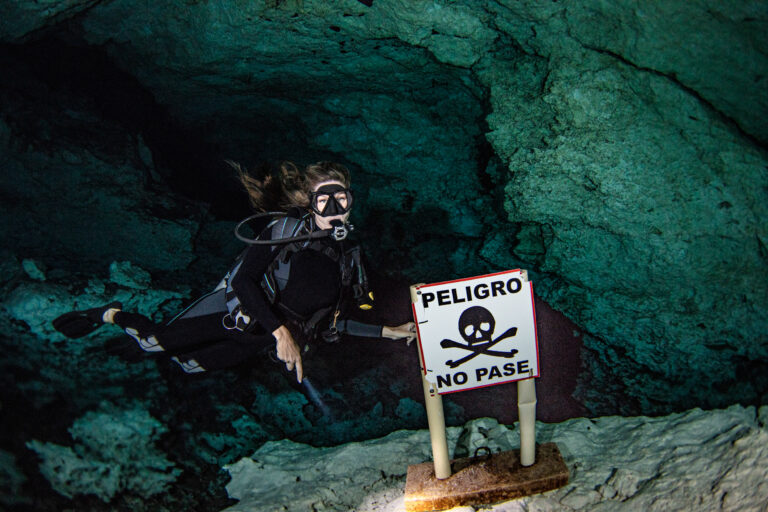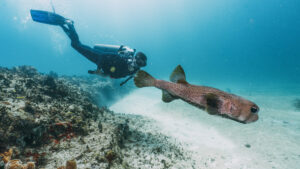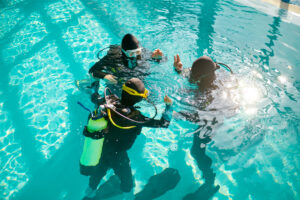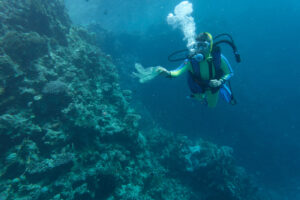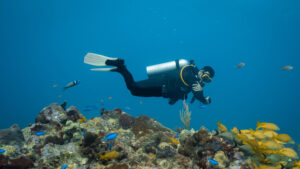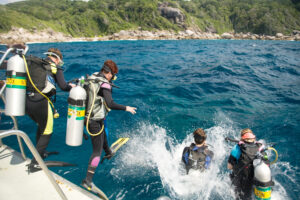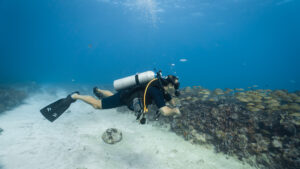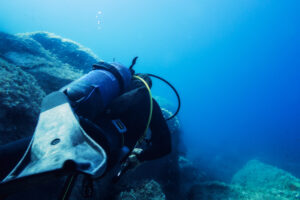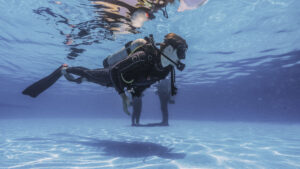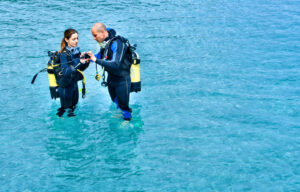What are Booties?
Booties are a critical component of scuba diving equipment designed to protect and insulate a diver’s feet in various underwater environments. They are typically used in conjunction with open-heel fins, offering both comfort and safety during dives. Their importance lies in shielding the feet from cold water temperatures and potential hazards like sharp rocks or debris that divers often encounter, especially during shore or wreck diving. This entry explores the construction, functionality, and selection of booties, alongside essential maintenance tips to ensure long-lasting performance.
Definition and Purpose
Booties, often referred to as dive boots or wetsuit boots, are specialized footwear that divers wear alongside open-heel fins. They are designed to fulfill two primary purposes: protection and insulation. First, booties shield the feet from potential hazards, such as sharp rocks, coral, or debris, which are common in underwater environments. This is particularly important for shore diving, where divers walk on rough or jagged surfaces before entering the water. Second, booties serve as insulation, protecting the diver’s feet from cold temperatures. Water temperatures can vary significantly depending on the location and depth, making thermal protection vital for maintaining comfort and safety underwater.
The functionality of booties depends heavily on their construction and materials. For cold-water diving, thicker booties provide better insulation, helping to retain body heat and protect against the discomfort and potential risks of prolonged exposure to low temperatures. In contrast, thinner booties are suitable for warm-water environments, where thermal protection is less critical. In addition to protection from physical hazards and cold, booties also offer a secure and comfortable fit inside open-heel fins, allowing divers to maneuver efficiently underwater without discomfort.
Materials and Construction
Booties are primarily made from neoprene, a type of synthetic rubber known for its flexibility, insulation, and durability. Neoprene is widely used in water sports gear due to its ability to retain heat while allowing for movement, which is crucial in underwater activities like diving. The thickness of the neoprene used in booties can range from less than 1 millimeter (mm) for warm-water diving to up to 7 mm for cold-water dives. As the neoprene thickness increases, so does the level of insulation. However, thicker neoprene can reduce flexibility, so divers must strike a balance between warmth and comfort.
In terms of sole construction, booties generally fall into two categories: soft-soled and hard-soled. Soft-soled booties are ideal for boat diving or environments where the diver will not need to walk on rough surfaces. These booties provide greater flexibility and comfort, making them popular for divers who prioritize ease of movement. Hard-soled booties, on the other hand, offer increased protection and are recommended for shore diving or other environments where divers are likely to encounter rocky or uneven terrain. The hard sole helps prevent injuries from sharp objects and ensures that divers can walk comfortably over rough surfaces before and after their dives.
The design of the bootie, including the height of the ankle cuff and the type of closure system, can also vary. Some booties come with zippers or Velcro straps to ensure a snug fit, while others rely on the natural elasticity of neoprene for a slip-on fit. These features not only contribute to comfort but also help prevent water from entering the bootie, thereby enhancing thermal insulation.
Sizing and Fit
Achieving the correct fit is essential when selecting a pair of booties for scuba diving. An ill-fitting bootie can lead to discomfort, blisters, or even reduced control of fins underwater. Booties should fit snugly without causing pressure points or restricting blood circulation. A proper fit ensures that the booties provide adequate insulation and protection, as well as comfort during long dives.
When trying on booties, it is important to do so while wearing a wetsuit or a similar layer. The added thickness of a wetsuit can affect the fit, and trying the booties on in similar conditions helps ensure a proper match. Many manufacturers offer booties in various sizes, including half sizes, to accommodate different foot shapes. Additionally, booties are often designed using unisex sizing, which can differ slightly from standard shoe sizing. To avoid sizing issues, divers should consult manufacturer sizing charts and consider customer reviews for guidance.
If a bootie feels slightly too large, divers can use neoprene socks or insole inserts to adjust the fit. These accessories can provide additional cushioning and warmth, improving overall comfort during the dive. On the other hand, if a bootie is too tight, it can cause discomfort and restrict movement, so selecting a slightly larger size is usually preferable if in doubt.
Types of Booties
Low-cut Booties
Low-cut booties are typically used for warm-water diving, where insulation is less of a concern. These booties generally have a thinner neoprene construction, often around 1 to 3 mm in thickness, and provide minimal coverage above the ankle. The lower cut allows for greater freedom of movement, making them ideal for divers who prioritize flexibility. Low-cut booties are commonly used in environments where the water temperature is warm, and the diver does not need significant protection from cold or physical hazards.
The soles of low-cut booties are usually soft, offering comfort and flexibility for boat diving or other situations where the diver is not required to walk on rough surfaces. These booties are favored for their lightweight feel and easy-to-wear design, but they offer less protection against sharp objects or cold water compared to high-cut alternatives.
High-cut Booties
High-cut booties, as the name suggests, extend further up the ankle, providing more coverage and support. These booties are typically made from thicker neoprene, ranging from 3 to 7 mm, to offer better insulation for colder water conditions. High-cut booties are often preferred by divers who dive in colder water or need additional protection when walking over rocky terrain or entering from the shore.
The increased ankle support provided by high-cut booties can also help prevent foot fatigue during longer dives. Depending on the intended use, high-cut booties may feature either a soft or hard sole. Divers who plan to engage in shore diving or wreck diving, where they may encounter sharp objects or uneven surfaces, will benefit from the added protection of a hard sole.
Drysuit Booties
Drysuit booties are specifically designed for use with drysuits, which are typically worn in extremely cold water environments. These booties are thicker than standard wetsuit booties and feature a watertight seal at the ankle to prevent water from entering. Drysuit booties are often used for ice diving or in other situations where the water temperature is near freezing, and the diver requires maximum insulation.
In addition to their increased thickness, drysuit booties are designed to integrate seamlessly with the drysuit itself, forming a complete barrier against cold water. Drysuit booties are generally less flexible than their wetsuit counterparts, but they offer superior thermal protection, making them essential for divers in extremely cold conditions.
Booties and Fins
Booties are typically worn with open-heel fins, which feature an adjustable strap that secures the fin around the heel of the bootie. The combination of booties and open-heel fins allows for a more comfortable and secure fit, especially in colder water, where full-foot fins may not provide enough warmth or protection. Open-heel fins are versatile and can accommodate different types of booties, provided that the bootie and fin are compatible.
When selecting a fin and bootie combination, divers should consider several factors, including water temperature, intended diving environment, and personal comfort. Thicker booties, for example, may not fit properly in certain fins, so it is important to ensure compatibility. Some fins are designed with adjustable straps that can accommodate a range of bootie thicknesses, while others are more restrictive in terms of fit.
In general, open-heel fins provide more power and control than full-foot fins, making them a popular choice for divers who require extra propulsion or need to navigate challenging underwater environments. The added protection and insulation of booties, combined with the adjustability of open-heel fins, create an optimal setup for a variety of diving conditions.
Bootie Maintenance and Care
Proper care and maintenance of booties are critical for ensuring they perform optimally and last longer. Booties endure harsh conditions underwater, including exposure to saltwater, sand, and sharp objects, making them susceptible to wear and tear. By taking the time to maintain them after each dive, divers can prevent unnecessary damage and preserve the insulating properties of the neoprene material. Neglecting bootie maintenance can lead to deterioration of the material, reducing their ability to provide warmth and protection during future dives. Regular care not only extends the lifespan of the booties but also ensures that they remain comfortable and safe for repeated use.
Without proper maintenance, booties can lose their flexibility and insulating qualities, which can negatively impact the diver’s experience. A good maintenance routine involves more than just rinsing off dirt; it includes drying the booties correctly, storing them properly, and performing regular inspections for potential damage. Maintaining a set of booties ensures they are always in good condition and ready for the next dive. This proactive approach to care helps prevent common issues, such as leaks or tears, which could jeopardize the diver’s comfort and safety underwater.
Rinsing
After each dive, it is essential to rinse booties thoroughly with fresh water to remove any salt, sand, or debris that might have accumulated during the dive. Saltwater can be particularly corrosive to neoprene, causing it to degrade over time and lose its elasticity. Sand and dirt particles can work their way into the seams and soles, gradually wearing down the material and reducing the durability of the booties. Rinsing the booties as soon as possible after diving helps prevent this degradation, ensuring that they remain flexible and capable of providing the necessary insulation and protection on future dives.
In addition to preserving the neoprene, rinsing booties also helps eliminate any buildup of bacteria or other microorganisms that can thrive in warm, damp environments. Failing to rinse booties properly can lead to unpleasant odors and, in extreme cases, cause skin irritation when worn for extended periods. Rinsing the booties in fresh water ensures that any residual salt or dirt is removed, promoting both hygiene and longevity. For best results, divers should rinse the inside and outside of the booties, paying particular attention to seams and soles where debris may accumulate.
Drying
After rinsing, booties should be dried thoroughly before storage to prevent the growth of mold and mildew. Air drying is the preferred method, as it allows the booties to dry naturally without exposing them to excessive heat, which can damage the neoprene material. However, it is important to avoid leaving booties in direct sunlight for extended periods, as ultraviolet (UV) rays can weaken the neoprene and cause it to become brittle over time. Direct sunlight also speeds up the breakdown of other synthetic materials used in the construction of the booties, further shortening their lifespan.
Turning booties inside out during the drying process can help ensure that the interior dries completely. This is particularly important because trapped moisture can lead to the growth of bacteria and cause the booties to develop a foul odor. Allowing the booties to dry fully, both inside and out, prevents moisture buildup and reduces the risk of material degradation. Ensuring that booties are completely dry before storing them is a simple yet effective way to maintain their insulating properties and avoid unwanted issues like mold or unpleasant smells.
Storage
When not in use, proper storage of booties is essential to maintaining their shape and functionality. Booties should be kept in a cool, dry place, away from direct sunlight and extreme temperatures. These conditions can cause the neoprene material to lose its flexibility and begin to degrade, especially if the booties are stored in an environment with high humidity or direct UV exposure. Long-term exposure to heat or sunlight can weaken the booties’ overall structure, making them less effective at insulating and protecting the feet during future dives.
It’s also important to avoid compressing or folding the booties during storage. Neoprene is a flexible material, but prolonged compression can cause it to lose its shape, leading to discomfort when worn. Booties should be stored in a way that allows them to retain their natural form, ensuring they remain comfortable and functional. By hanging them up or placing them in a storage bag specifically designed for diving gear, divers can prevent creases and maintain the structural integrity of the booties. Proper storage practices go a long way in extending the lifespan of booties and ensuring they remain in good condition for every dive.
Inspection
Regularly inspecting booties is a proactive way to identify potential issues before they become serious problems. Divers should check their booties for signs of wear and tear, such as small holes, tears, or separation at the seams. These issues, if left unaddressed, can compromise the booties’ ability to provide protection and warmth during a dive. Even minor damage can allow cold water to seep in, which not only reduces insulation but also increases the risk of foot discomfort or injury. By catching damage early, divers can address small problems through repairs before they worsen.
In addition to checking for physical damage, divers should also examine the soles of the booties to ensure they remain intact and capable of providing adequate protection on rough or rocky surfaces. A damaged or worn-out sole can make shore entries more hazardous and reduce the overall comfort and safety of the dive. If any issues are identified during inspection, repairs should be made as soon as possible. Many small tears or holes can be fixed with neoprene glue, but in cases of extensive damage, replacing the booties may be the best course of action to ensure safety and comfort underwater.
Bootie Selection Tips
Choosing the right pair of booties for scuba diving involves several key considerations, all of which can impact a diver’s comfort, safety, and overall experience. One of the most important factors is the water temperature, as booties with the appropriate thickness are crucial for maintaining warmth. Divers planning to dive in cold water should opt for thicker neoprene booties, which provide better insulation, while thinner booties are sufficient for warm-water dives. Wearing booties that are too thin for cold water can result in discomfort or even hypothermia, while unnecessarily thick booties in warm water may lead to overheating and reduced mobility.
In addition to water temperature, the diving environment should be taken into account. Shore diving or dives in environments with rough terrain may require hard-soled booties, which offer superior protection against sharp rocks, coral, or other debris. For boat diving or situations where divers do not need to walk on challenging surfaces, soft-soled booties may be preferable due to their increased flexibility and comfort. By carefully considering the environment and temperature, divers can select booties that enhance their underwater experience and ensure optimal protection.
Water Temperature
Water temperature is one of the most critical factors to consider when choosing booties, as it directly affects the level of insulation required. In cold-water environments, such as those found in temperate or polar regions, divers need booties made from thicker neoprene, often ranging from 5 to 7 mm, to provide adequate insulation. Thicker neoprene helps retain body heat and prevent cold water from coming into contact with the skin, keeping the diver warm and comfortable throughout the dive. Wearing the wrong thickness can lead to discomfort and even hypothermia, especially during extended dives in frigid waters.
Conversely, in warm-water diving, where thermal protection is less of a concern, booties with thinner neoprene, typically around 1 to 3 mm, are more suitable. These booties offer enough protection without causing overheating, allowing for more freedom of movement and comfort in tropical or subtropical waters. Divers should always consider the temperature of the water they will be diving in and select booties that provide the right balance of warmth and flexibility to match the conditions.
Diving Environment
The type of diving environment also plays a major role in bootie selection, particularly when considering the level of foot protection needed. Shore diving, for example, often requires divers to walk across rocky or uneven terrain before entering the water. In such cases, hard-soled booties are recommended, as they offer better protection against sharp objects and provide more stability when walking on rough surfaces. These booties can prevent injuries and make shore entries safer and more comfortable for the diver.
For divers who primarily engage in boat diving or dives in environments with smooth surfaces, soft-soled booties may be a better choice. These booties are lighter and more flexible, making them ideal for situations where walking on land is minimal or unnecessary. Soft-soled booties provide greater freedom of movement and comfort during the dive, enhancing the overall experience without sacrificing foot protection. By selecting booties based on the diving environment, divers can ensure they have the appropriate level of protection and comfort for their specific needs.
Fit
Ensuring a proper fit is perhaps the most important aspect of selecting booties, as an ill-fitting bootie can lead to discomfort, blisters, and even loss of fin control. Booties should fit snugly without being too tight, allowing for a full range of movement while preventing water from entering. If booties are too loose, they can cause chafing and may reduce the effectiveness of the insulation. Conversely, booties that are too tight can restrict blood flow and cause discomfort during the dive, potentially leading to cramps or other issues.
When trying on booties, divers should do so while wearing a wetsuit or a similar layer, as this will affect how the booties fit. Additionally, different brands and styles may fit differently, so it’s important to consult sizing charts and read reviews from other divers for guidance. If necessary, divers can use neoprene socks or inserts to fine-tune the fit, ensuring maximum comfort and insulation. Taking the time to ensure a proper fit will help enhance both comfort and performance during dives.
Compatibility
Finally, it is essential to ensure that the selected booties are compatible with the diver’s fins, particularly if using open-heel fins. Thicker booties may not fit properly into certain fin foot pockets, leading to discomfort or reduced control underwater. Divers should verify that their chosen booties and fins are compatible, paying special attention to the thickness of the neoprene and the design of the fin’s foot pocket. Some fins are adjustable and can accommodate a range of bootie sizes, while others may be more restrictive.
In addition to checking fit, divers should also consider how well the booties and fins work together in terms of overall performance. The combination of booties and fins should provide a secure and comfortable fit, allowing the diver to move efficiently through the water without experiencing any slippage or discomfort. Ensuring compatibility between booties and fins is a crucial step in selecting the right gear for a safe and enjoyable diving experience.
Key Takeaways
Booties are a crucial element of scuba diving gear, providing both insulation and protection for divers’ feet in various underwater conditions. Understanding the different types of booties, their materials, and their intended uses allows divers to select the best option for their specific needs. Maintaining and caring for booties properly ensures their longevity and enhances the overall diving experience.

